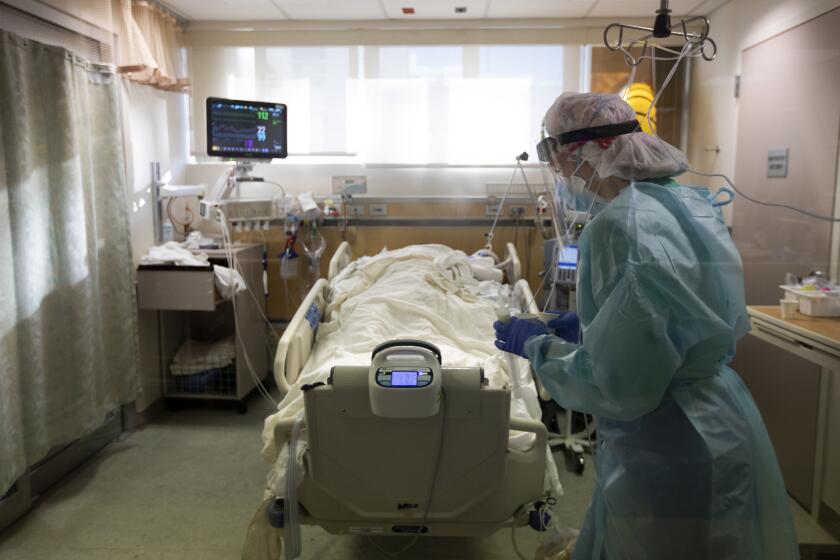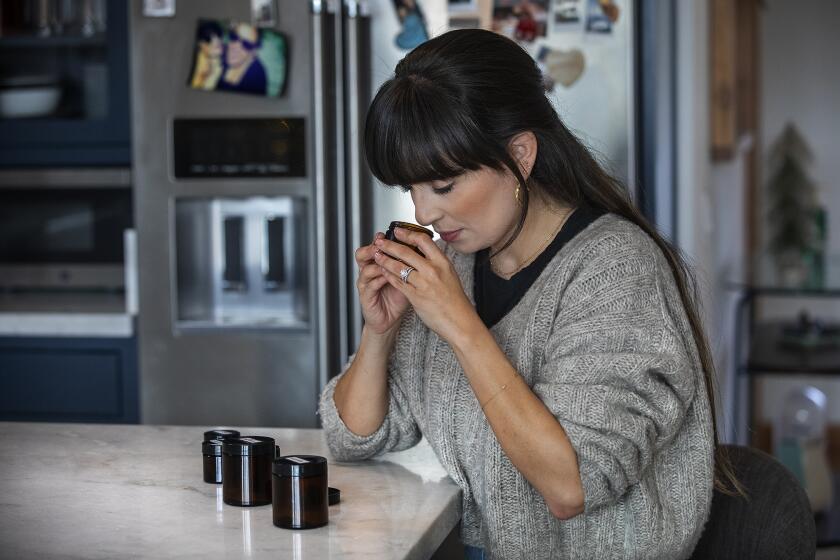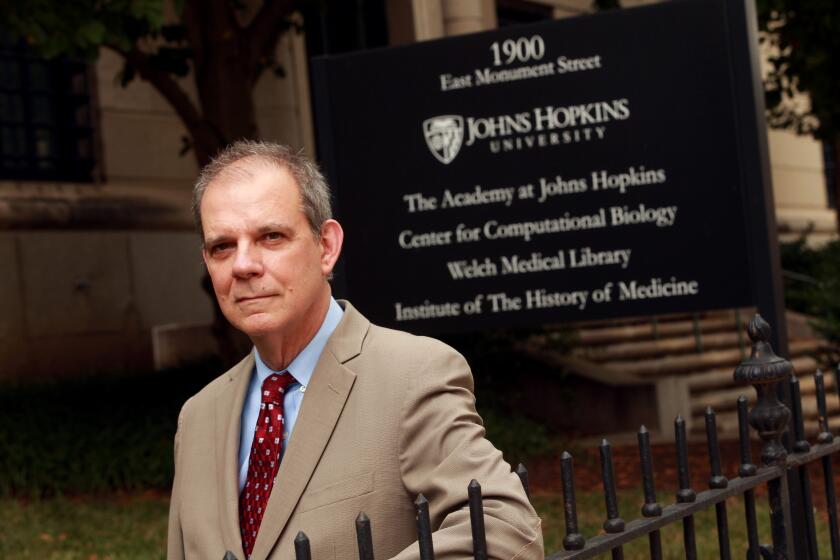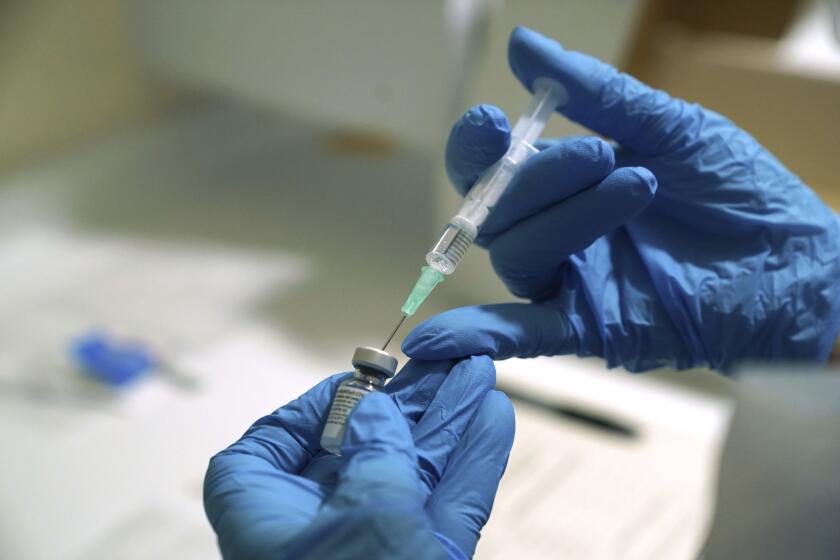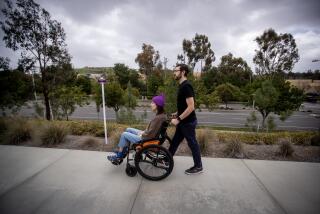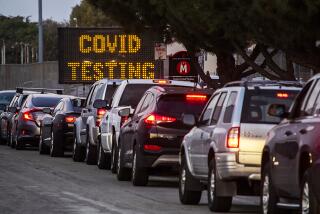Cases of ‘long COVID’ frustrate patients, puzzle scientists
- Share via
Larry Searight awakens each morning in Palmdale, often before dawn, to the kind of pandemic nightmare that has roiled the sleep of many over the past year.
A scourge that never ends. A world that thaws and moves on but leaves him stuck and unable to keep up. Terrifying physical sensations that descend without warning and disappear just as suddenly. Friends and doctors turning away in disbelief. The mounting losses — of joy, of taste and smell, of mental firepower.
For Searight, 62, this is what COVID-19 has left behind. A year out from a two-week episode of chills, cough and exhaustion, he is at the daily mercy of a revolving array of symptoms — many of them profoundly disabling — that come and go without warning.
Searight is one of hundreds of thousands of Americans, and probably millions more across the world, who have shaken off a coronavirus infection but still contend with persistent, and perplexing, aftereffects.
Among those with “long COVID,” headaches, fatigue and shortness of breath are common. Problems with memory, concentration, sleep and balance abound. Athletes and fitness buffs who scarcely noticed they were ill find that, months later, they can no longer exercise due to heart palpitations, grinding fatigue and muscle weakness.
Their numbers go well beyond the minority of patients who were put on ventilators, or who nearly died because their immune systems overreacted to acute infection. Patients who have sustained organ damage face medical challenges that are complex, but not mysterious.
By contrast, “long haulers” such as Searight are an enigma on many levels. Who they are and how many of them remain ill after a SARS-CoV-2 infection are unknown. What drives their bizarre array of symptoms is, as yet, unexplained. Their prognoses remain uncertain. And so is the answer to the most pressing question: How can they be helped?
Their existence, however, is undeniable.
Already, the pandemic has generated more than 115 million confirmed COVID-19 survivors worldwide, including at least 30 million in the United States. If even a tiny fraction of them develop long COVID, they will probably present a massive challenge to healthcare systems.
One early indicator of their growing presence: Hospitals in 32 states and the District of Columbia have established programs or clinics specializing in the care of patients suffering persistent symptoms after coronavirus infection.
COVID-19 patients who take months to overcome their coronavirus infections despite treatment can become incubators of dangerous new strains.
One of those fledgling programs is at Cedars-Sinai Medical Center in Los Angeles. There, Searight has found a champion in Dr. Catherine Le, an infectious disease physician who co-directs the hospital’s COVID-19 Recovery Program.
In early March 2020, Searight suffered flu symptoms. They seemed to have resolved by mid-April.
But a few weeks later, they came back with a vengeance. A diagnostic test for COVID-19 showed he did not have an active infection. Go home, he was told. You’re fine.
Searight knows he is not fine. An aerospace engineer and high school math teacher, he now reaches for a calculator to do operations he once completed in his head. A jazz singer whose music got national airplay, he finds himself unable to remember lyrics, and far too exhausted to improvise. His heart races without warning, and his body temperature periodically drops below the level his thermometer can detect.
Some days, he says he is overtaken by a fatigue so profound “it feels like my spirit is being sucked out of my body.” He experiences unpredictable bouts of pain — in his legs and hands that feel like a recurrence of shingles; in his chest, which make him think he’s having a heart attack; in his kidneys, which can immobilize him for days.
Tests of his lungs, brain, kidneys, heart and gut do not confirm his worst fears. Indeed, they find nothing amiss at all.
“What else can I do?” one doctor asked Searight in exasperation. “I’ve done my job.”
Loss of smell is a common symptom of COVID-19, and about 10% of patients suffer from long-term smell dysfunction. Can the nose be retrained to detect odors correctly?
Friends are at a loss to understand his twilight world between actively ill with COVID-19 and fully recovered. It could have been worse, they suggest: At least he didn’t die.
The isolation, dismissal and barrage of physical insults have tested Searight’s well-honed resilience. A gay Black man, he lived in the closet for decades and emerged to marry his partner of 21 years in 2015. He has navigated racism, subtle and overt. He is not easily discouraged.
But the symptoms that plague him now can be overwhelming.
“I don’t know if I ever will be on the mend,” he said. “That uncertainty takes an emotional toll that no one talks about: I’d almost rather know I was going to die.”
That uncertainty takes an emotional toll that no one talks about: I’d almost rather know I was going to die.
— Larry Searight, who suffers from Long COVID
Searight is far from alone in his struggle to recover. Like-minded patients have emerged as a potent force for support and advocacy.
Some are making common cause with patients who suffer from other poorly understood ailments such as chronic fatigue syndrome, fibromyalgia and chronic Lyme disease. Those patients’ diffuse symptoms frequently follow an infection too, and their complaints are routinely belittled and dismissed by doctors.
Dr. Anthony Fauci, the nation’s leading infectious disease doctor, says long COVID is “really puzzling.” In the “data-free zone” that now exists, Fauci says it’s impossible to know how many are affected, why the virus doesn’t seem to be done with them or how long their symptoms could last.
In the absence of lab tests that can diagnose the problem, “a lot of times people think it’s a psychological disorder,” Fauci said. “It’s not.”
Preliminary reports suggest that around 70% of patients coming forward are women — a pattern that has historically led doctors to dismiss symptoms as manifestations of feminine anxiety. “We’re not going to assume this is hysterical by any means,” Fauci said. “I think this is a real situation.”
Scientists searching for a medicine to treat patients with COVID-19 are looking for it in the blood of people who have already survived the disease.
Searight has seen such dismissal before: In the mid-1980s, his mother, Dorothy Searight, suffered a sudden attack of pain and paralysis. Though she was eventually diagnosed with Guillain-Barre syndrome, her doctors offered no treatment for the condition. She coped with her disability for years.
“She’s my North Star,” Searight said. “She just figured out a way to continue to live and adapt to her new circumstances. I’m learning to reconstruct my life too.”
The National Institute for Allergy and Infectious Diseases has launched a comprehensive effort to define long COVID — a four-year, $1.15-billion initiative that will establish patient registries along with central repositories for data and biological specimens.
The medical establishment has also given the affliction a new moniker — Post-Acute Sequelae of COVID, or PASC. The act of assigning a clinical name to a new diagnosis is as standard as giving it a billing code. But to some patients, it’s an unwelcome display of paternalism.
“I have deep qualms with the name PASC,” said Diana Berrent, a New Yorker who became one of the country’s first recognized COVID-19 patients a year ago and has suffered headaches, brain fog, deep inner-earaches, and vision changes ever since.
“It is way too early to call it post-anything,” Berrent said. “We don’t have an understanding of the etiology of this disease to say that it’s anything — much less past.”
She worked as a professional photographer until she awoke on March 13, 2020, with chest pain and fever. After chronicling her own bout with COVID-19, she founded Survivor Corps, a resource and virtual gathering place for people affected by COVID-19. Its website has been inducted into the Library of Congress’s digital history of the pandemic. Its Facebook group boasts more than 157,000 members, virtually all of whom have identified persistent post-COVID symptoms.
All that has made Berrent a power broker in the long COVID patient community. She has generated valuable data for researchers and mobilized an army of recruits for clinical trials. She slings medical jargon with facile fluency and insists MDs and PhDs treat her “as an absolute peer.”
In return for their help, Berrent says, Survivor Corps members want respect. They want a voice in how research is conducted, findings are disseminated and treatment is delivered. Most of all, she says, they want answers.
Long COVID sufferers “have stepped forward ahead of the scientists,” said Dr. Harlan Krumholz, director of Yale’s Center for Outcomes Research & Evaluation. “They are not standing around waiting for scientists to come up with insights, but recognizing that there’s power and wisdom in their experience.”
Indeed, anecdotal data, including symptom surveys that have been collected by Survivor Corps, have fed the intuitions of scientists and shaped their research plans.
At Yale, immunobiologist Akiko Iwasaki has proposed to study a curious and potentially telling phenomenon: that many long COVID sufferers report relief from their symptoms after receiving one of the COVID-19 vaccines.
Iwasaki is a revered figure among long COVID patients. In June, well before the old guard took the affliction seriously, Iwasaki was willing to discuss the factors that might give rise to such an array of symptoms.
One of her ideas is now a leading hypothesis among scientists. She suggests that for some people, a coronavirus infection sets off an autoimmune response that causes the body’s defenses to overreact or misfire, attacking healthy tissue even after the threat has passed. That jibes with well-established evidence that it’s often not the virus itself that threatens patients but the immune system’s overzealous reaction to it.
Iwasaki has postulated two other possible mechanisms by which the SARS-CoV-2 virus might wreak havoc long after tests have ceased to detect its presence.
Perhaps once it’s been excised from the nose, throat and lungs, it may hide in places that are generally protected from the immune system — the brain, the eyes or some reproductive organs. The viruses that cause Zika and Ebola are known to do this, and autopsy studies have found evidence of SARS-CoV-2 in the brains of COVID-19 victims. That might account for the cognitive problems associated with long COVID.
Iwasaki also posits that COVID-19 may leave behind coronavirus proteins and fragments of viral RNA. These “viral ghosts” can’t invade cells, but they can tease the immune system, disrupt certain cells and organs, and gum up the works.
Mixing and matching doses of different COVID-19 vaccines was an idea that scientists dismissed out of hand. Now they’re taking it seriously.
This could explain why roughly a third of long COVID patients improved after getting a dose or two of COVID-19 vaccines. Both induce broad immunity — perhaps enough to recognize and attack left-behind viral fragments. If a clinical trial bears this out, long haulers might get periodic booster shots to manage their symptoms.
David Putrino, a neuroscientist and physical therapist at Mount Sinai Hospital in New York, says dismissing long COVID as a psychiatric disease is a “lazy diagnosis.” But treating patients’ mental health will help them manage their debilitating symptoms.
“Extreme emotion will trigger symptoms,” Putrino said. That’s especially true for people with autoimmune diseases and syndromes that perturb the body’s autonomic nervous system, which governs everything from temperature and heartbeat to balance and digestion.
“Patients need to understand that before this insult to your body happened, you didn’t necessarily have to regulate your emotions,” he said. “Now you do, or there will be consequences.”
When Searight appeared at Cedars-Sinai’s long COVID program, he received more empathy than advice from Le, the infectious diseases specialist.
Le told Searight she did not have answers or a bag of proven tricks. But she listened and asked questions. And then she listened some more.
“It was like angels descended from heaven,” Searight said. “Just to share and for her to look back at me and nod in affirmation — that was in and of itself healing.”
